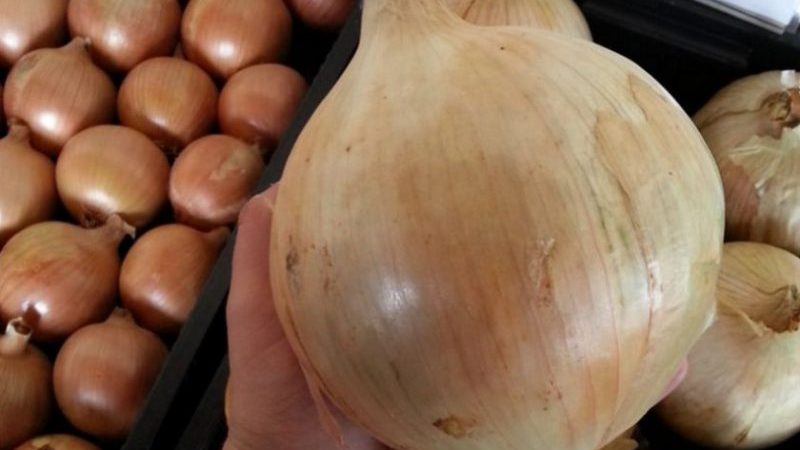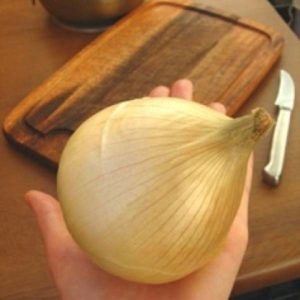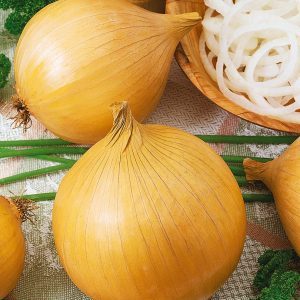Large mid-season variety of onions "Globo": reviews of summer residents and features of agricultural technology
Onion grown in more than 175 countries around the world. Among the variety of varieties, Globo is one of the ten best in terms of its characteristics: large bulbs, weighing 800-1000 g, juicy, without bitterness and pungent odor, are suitable for use fresh. During the season, full-fledged vegetables grow from seeds.
The content of the article
What kind of onion is this
Globo variety is late-ripening and high-yielding. Grows in different climatic zones, resistant to major diseases.

Origin and development
Globo was bred by breeders of the Czech company "Semo", founded in 1994. The variety is not included in the State Register of the Russian Federation. Onions quickly became in demand in Europe, Russia, Ukraine, Belarus, Crimea. Due to its large size, at first it was considered exotic - now it grow throughout Russia.
Features:
Globo differs from other crop varieties:
- the duration of the growing season - 120–160 days from planting to harvest;
- the weight of the bulbs is 800–1000 g;
- elliptical shape of vegetables;
- sweet taste.
Plant and yield characteristics
Globo grows a aligned large turnip with light juicy scales. Green shoots reach 50 cm in height. The color of the feathers is bright green, due to their mild taste, they are suitable for salads. Vegetables ripen large, regardless of the use of greens, if the onion grows from a set.
Important! When grown from seeds, feathers are not plucked so that the onion reaches the varietal size. The thicker the tops, the higher the yield.
10–12 kg of large vegetables are harvested from 1 m2.
How to grow
Globo is grown in three ways: from seeds through seedlings, planting seedlings or direct sowing into the ground.
Seed preparation begins in February. To do this, they are soaked for 2-3 hours in warm water. The emerging specimens are removed, and the remaining ones are disinfected in a warm dark solution of potassium permanganate (1 g per 1 l of water) for 6–8 hours.
The seeds are placed in a soil mixture of humus, turf and mullein (9: 10: 1), sprinkled with loose earth, covered with foil. Small cups 10 cm deep are suitable as containers.
The air temperature is maintained at + 20 ... + 22 ° C. Seedlings appear on 7–12 days, after which the film is removed. The temperature is gradually reduced to harden the seedlings.
Since green shoots appear in winter and spring with short daylight hours, they need additional lighting.... Water the sprouts with water at room temperature every 3 days.
In the second method of cultivation, onion sets purchased or grown from nigella are placed in a warm solution of potassium permanganate for 1 hour. Gently cut off the tops of vegetables to stimulate growth.
Direct seeding into the ground simplifies cultivation, but is only available to vegetable growers in the southern regions. In colder climates, this planting method will not give a high yield; in a short growing season, the bulbs will not reach the varietal value. Another disadvantage is the increased consumption of planting material.
Terms and rules of landing
Globo is a cold tolerant onion variety. Seeds are planted when the ground warms up to + 10 ° C, sowing - up to + 5 ° C. In regions with a warm climate, this is mid-March, in central Russia, Siberia and the Urals - early May, in central regions with a temperate climate - late April.
Seedlings of the Globo variety dive according to the scheme recommended by the manufacturer:
- depth - 5 cm;
- the distance between plants is at least 15 cm;
- the interval between the beds is at least 20 cm.
Similar parameters are observed when growing through a set.
Reference. Reduce the distance between shoots when thinning the onion further for the use of greens in the summer.
To obtain large vegetables, the soil in the beds is prepared since the fall. To do this, remove plant residues, carefully dig up the earth, add humus and phosphorus-potassium fertilizers. In winter, the soil assimilates nutrients, which, during active snow melting, get deep inside.
In the spring, add to the soil per 1 m2:
- superphosphate - 60 g;
- urea - 10 g;
- potassium chloride - 20 g.
When planting crops, the rules of crop rotation are observed. Good predecessors of onions are cabbage, potatoes, eggplant, tomatoes, zucchini, pumpkins. The area after radish, dill, peas is not suitable.
Care
The variety is unpretentious in care, but requires compliance with elementary agrotechnical techniques:
- Watered onions as the soil dries. First, at least once every 3-4 days for 2-3 weeks, then the intervals are increased to 6-7 days, and 3-4 weeks before the expected harvest, irrigation is stopped. After each moistening, the soil is loosened, saturating it with oxygen and removing the formed crust.
- Regularly remove weeds from the bedstaking nutrients from the soil. Covering the ground with weeds reduces the yield by half.
- Feed Globo infusion of nettle at the stage of formation of green mass. Fertilizing will accelerate crop growth and increase the size of the bulbs.
- 3-5 days before harvesting, they rake off the soil from the vegetables, so that they stop growing and dry out.
Possible difficulties, diseases and pests
The cultivar has no peculiarities of cultivation. Difficulties arise during a rainy summer, when the soil does not have time to dry out and the bulbs rot. In such seasons, Globo is not watered, the soil is often loosened, and in the fall the harvested crop is dried in the sun for two weeks.
With proper care and observance of crop rotation, Globo practically does not get sick. In cold and rainy summers, onions are susceptible to peronosporosis, or powdery mildew. Signs of illness:
- rusty spots on the leaves;
- feathers bend to the ground;
- purple bloom on the bases of the bulbs.
For prophylaxis, the seed is disinfected, the culture is planted in a sunny place, the crop rotation is observed, water stagnation in the garden is not allowed, weeds are removed on time. Against powdery mildew, plantings are sprayed with a soapy solution with wood ash.
Of pests on onions are found:
- Onion flies - light gray insects, similar in appearance to common flies. They lay eggs on the leaves, the grown larvae feed on young plants, destroying them. Mukhoed and Medvetoks are used against pests.
- Thrips - hibernate in dry onion skins, in season feed on juicy pulp. They use Aktara to fight.
- Weevils - damage the leaves of vegetables, piercing them with their long needle-like nose. The source of infection is last year's plant residues left in the soil. Getting rid of insects is difficult.
Collection, storage and use of the crop
Yellowed and fallen tops are a sign of onion ripeness. Harvested in dry, sunny weather. The vegetables are dried for 7-10 days in the fresh air, but not in direct sunlight. The dry tops are cut off, leaving a small neck 1 cm in size. The dried husk is removed.
They store vegetables at home: in special nets, nylon stockings, boxes, wicker baskets. During the winter, the bulbs are checked several times, dried or decaying specimens are removed.
Important! Do not keep onions in plastic bags. They allow moisture and air to pass through, so vegetables quickly fog up and rot.
The variety is suitable for fresh consumption: juicy sweet onions are added to salads, pizzas, marinated for barbecue.
Advantages and disadvantages

The main advantages of Globo:
- the size of the bulbs;
- juicy sweet pulp without a spicy aftertaste;
- unpretentious care;
- undemanding to the composition of the soil and climate;
- resistance to diseases of culture.
The disadvantage of the variety is the long growing season (120–160 days).
For which regions is it suitable
The variety is cold-resistant, has proven itself in all regions of Russia. The seed growing method is suitable for the southern regions, seedling and seeding for the rest.
Farmers reviews
Vegetable growers from different regions of Russia share their impressions of growing Globo.
Irina, Sarapul: “I have been cultivating black onions for several years: this method is beneficial. I tried different varieties, but Globo pleased most of all. The bulbs have reached 750 g, they taste sweet, they are irreplaceable in salads. Recommend!".
Tatiana, Irkutsk: "I did not believe it when they said that the Globo and Exhibishen bulbs reach a weight of 1 kg. I decided to try it. Of course, it is troublesome and slow to grow through seedlings, but the result is worth it. Globo won: his turnips reached 1 kg, while those of Exhibits - 800 g. In one season he managed to get a large juicy onion. There were no particular problems with seedling cultivation, just a little earlier the start of the garden season. "
Natalia, Krasnoyarsk: “For the third year I have been growing Globo onions with seeds. The seedlings are strong if humus is added to the ground. I collect large bulbs: 10 cm in diameter. They are without bitterness, therefore I use them in salads and preparations. They do not last long - we try to eat it during the winter. "
Conclusion
Onions are an irreplaceable vegetable on the table, especially in the cold season, but not everyone likes its taste. The Globo variety grows sweet and juicy onions without bitterness, which are suitable for consumption raw.
The culture is unpretentious in care, has a strong immunity, bears fruit in all regions of the country. The main advantages of the variety are the impressive size of vegetables and high yield. We recommend you try it!